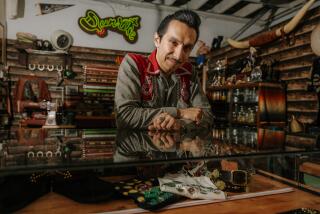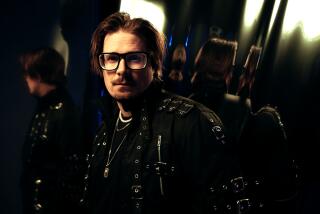Old school Old West
The rich and famous don’t come by Al Shelton’s place in Studio City as often as they once did. For one thing, the barrel-bellied ex-bronco buster has outlived Gene Autry, Steve McQueen, Ronald Reagan, Clark Gable, Jack Lemmon and other celebrity patrons who once clamored for the custom-crafted leatherwork embossed with Shelton’s iconic cowpoke imagery.
Then too, westerns aren’t what they used to be.
And that’s OK by him. These days, Shelton, 84, onetime cowboy artist to the stars, would be just as pleased with the company of a stray cat. “I don’t have a cat now, but I am open to another one coming around,” says Shelton, dressed in his customary pearl-buttoned cowboy shirt, flared brown pants and boots on a recent weekday.
In the dinky backroom of his curio-crammed storefront, Shelton polishes off lunch -- one slice of white bread, bologna, catsup -- then ambles toward his workbench to scrutinize the intricately tooled leather covering he’s making for the Martin Guitar Co.’s new museum in Nazareth, Pa.
Martin commissioned the piece on the strength of a leather-tooled cover for a guitar Shelton carved for Ricky Nelson in 1957. The yellowing tracing paper for that rosette and scroll design lies in a pile of old notebooks, photographs and articles.
“I don’t have much of a filing system,” rumbles Shelton, his raspy twang sounding like it’s been filtered through a slurry of gravel, whiskey, barbed wire and tumbleweed.
“I’ll tell you how that worked out: Ricky wasn’t old enough to drive, so his brother, Dave, brought him here and told me they saw Elvis Presley and wanted a guitar like his. I sort of put a little act on ‘em. I said, ‘No way would I try to duplicate Elvis.... But I’ll be glad to do a better job than that!’ Heh heh heh.”
Shelton befriended the young teen idol and even taught Nelson a few chords on the guitar. “Three months go by and Rick comes back here to show me how he was doing, playing all these fancy runs. Boy, he just passed me up like a dirty shirt, and I started learning from him.”
Offers for his collection
Flanked by an Indian restaurant, dry cleaner and adult video store on a stretch of Ventura Boulevard marked with a “Gilligan’s Island” plaque, the Al Shelton Western Artist store comes across as a Wild West diorama, stuffed with midcentury treasures. Because of the time-consuming Martin Guitar project, Shelton is not taking orders for new work. In the past, he’s charged from $400 to $1,500 for belts and up to $5,000 for unusually elaborate chair backs or guitar covers. However, he says, people are welcome to drop by.
“This place is like a museum, has been for years,” he says.
Twice, he’s turned down offers to purchase his entire collection. Now, he’ll consider offers. “My latest decision is, I can’t take this stuff with me, and I’m getting on the old-ish side, you know. So anybody’s serious and they want some of this work, they gotta make me an offer. If I think it’s a fair price, they can have it.”
Scattered amid the horseshoes, lariats, wagon wheels and leather-relief portraits of Will Rogers are more recent artifacts:
* Sly Stallone’s boxing gloves, used as the model for a “Rocky 2” belt buckle, hang near Shelton’s bench.
* A letter from Reagan gathers dust beneath a glass case, along with buckles commemorating Burt Reynolds’ football team and Tom Selleck’s “Magnum P.I.” series.
* Sketches for guitar straps, leather chairs, buckles and script books, and overnight bags Shelton produced for Mac Davis, Glen Campbell, Jackie Chan, Angie Dickinson, Sally Field, James Garner, Anjelica Huston and Barbra Streisand are stowed among the belt-punching contraptions, sewing machines and electric saws.
Not that Shelton is, or was, particularly star-struck. “I never paid it much mind or let it go to my head,” Shelton growls. “I just tended to my own business. Every job, I did the best I could, because every job, my reputation’s at stake. You start cutting corners, something like that travels fast too.”
Assuming a splay-legged stance behind the same workbench where he once took a belt order from Gable, Shelton selects a nail-shaped stamping tool of his own design, picks up a baton mallet and hammers a delicately dimpled pattern into a swatch of cowhide. He still possesses the smooth, pink hands of a 25-year-old, but decades at the bench have taken a toll on his hearing.
“You’re pounding down the background so the design is actually raised up,” Shelton explains. “That’s basically what’s the matter with my ears. I’ve got 80% hearing loss. All this pounding, pounding, pounding.”
Shelton also has eye problems caused by a near-fatal 1936 car crash. “That pretty near killed me,” he says. “Unconscious five days. Broken back. Hemorrhage of the brain. I was supposed to stay in bed until my vision got better. You can’t stay in bed all that time when you’re 16! So I still have double vision. Just this morning I had a flash. Well, I don’t want to worry about it. I’m hoping to get this guitar carved before I get too far gone.”
Shelton’s friend and protege Brennan Byers, who crafted the leather gear used in the movie “Pirates of the Caribbean,” describes his mentor as an uncommonly gifted artisan schooled in a nearly extinct code of honor. “He’s a piece of living history,” Byers says. “You tell some teenager that somebody you know broke horses for the U.S. Army, they look at you like you’re from Jupiter.”
Started in a saddle shop
Shelton grew up in a small Colorado town, quit school at 14, hit the road three years later during the tail end of the Depression and wound up at a Wyoming ranch herding cattle and taming wild horses. Shelton married briefly -- his daughter lives in Seattle -- before finding his metier at a Fort Collins, Colo., saddle shop in 1943.
He remembers, “I went up to the head carver, showed him my billfold I’d done a little work on, and he said, ‘That’s pretty good; how would you like a job doing this?’ So I started at 50 cents an hour, which wasn’t that bad in those days. I caught on pretty quick.”
After the war, Shelton came to California and plied his trade at the Los Angeles Farmers Market, attracting tourists as well as rival carvers eager to poach his tooling techniques. In 1957, after a five-year stint with Nudie Cohn, the famed country and western outfitter, Shelton hung his shingle at 12317 Ventura Blvd. An admirer of Western artists C.M. Russell and Frederic Remington, Shelton says, “I always thought my timing was wrong because I wanted to live in the old cowboy days.”
In fact, Shelton’s timing was perfect. He set up shop in Studio City just as TV westerns were taking off. Actors pretending to be cowboys at the nearby production lots were thrilled to have Shelton lend a stamp of authenticity to their belts and leather-backed directors chairs.
Shelton later took up oil painting and in 1972, he devised his own system for sculpting detailed wax miniatures used to cast limited-edition bronze belt buckles. “This new business kept me going nearly full blast for 10 years,” Shelton says. “Then, like a change in the weather, westerns died and so did buckles.”
When he was 68, Shelton contributed the boots, saddle work and holsters for the Gene Autry “Back in the Saddle Again” sculpture at the Museum of the American West, which owns four other pieces as well. “Probably the most spectacular thing we have is a saddle he made for the TV program ‘Tales of Wells Fargo,’ ” says Michael Duchemin, a senior curator at the museum. “The leather is carved to have a filigree effect and there’s a gold foil laid down underneath it, so when that saddle was on a horse and the star, Dale Robertson, was riding, that gold foil would sparkle in the sun showing through the carved leather work.
“The level of intricacy is just amazing. Who would be insane enough to take the time to do all that work? It’s a labor of love that reminds me of some of the really intricate Chinese craft.”
An unexpected guest comes through the door. It’s Paul Marshall, a studio musician from Tujunga. Shelton disappears into the store’s dimly lighted recesses, returns with a couple of acoustic guitars, hands one to Marshall and plunks himself down on a stool. The pair start strumming, immune to the cars whizzing by outside. A few shafts of late afternoon sunlight penetrate the old man’s shop as Shelton rears his head back and begins wailing the 1957 Roy Acuff ballad “Blue Eyes Crying in the Rain.”
“Love is like a dying ember
Only memories remain
Through the ages I’ll remember
Blue eyes crying in the rain.”
“That’s a beautiful little song,” Shelton mutters. “I’ve been doing it for a while. A lot of people cry when I do this song. Maybe, like me, they just cry easy.”
More to Read
The biggest entertainment stories
Get our big stories about Hollywood, film, television, music, arts, culture and more right in your inbox as soon as they publish.
You may occasionally receive promotional content from the Los Angeles Times.










